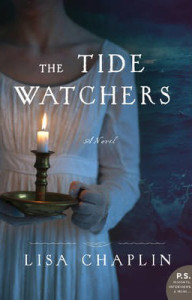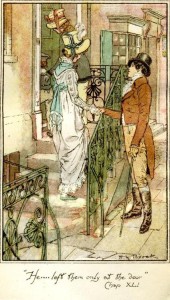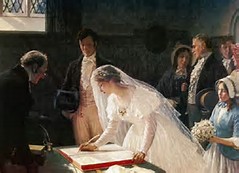 Congratulations to Angelina J who was the randomly selected winner of Lisa Chaplin’s The Tide Watchers!
Congratulations to Angelina J who was the randomly selected winner of Lisa Chaplin’s The Tide Watchers!
Look for an email from me!
Thanks to all for making my friend Lisa feel welcome.
 Congratulations to Angelina J who was the randomly selected winner of Lisa Chaplin’s The Tide Watchers!
Congratulations to Angelina J who was the randomly selected winner of Lisa Chaplin’s The Tide Watchers!
Look for an email from me!
Thanks to all for making my friend Lisa feel welcome.
EDITED TO ADD: Thanks you to all the contestants. I have decided that all the timely commenters are winners. I will be emailing you!
I’ve been blogging about the research I did for my story in the upcoming anthology Dancing in The Duke’s Arms. My research included such topics as songs, cheese, cattle, and plants. From that you might conclude my story is about a singing dairy maid who moonlights as an herbalist. But you would be wrong. (INORITE???!??)
To celebrate I will send five winners a mystery prize(s). For each prize(s), I will spend at least $15.00 US. If you hang out here, you probably know that I have impeccable taste except when I am odd or just plain weird. There’s just no telling. To enter, check out the rules below and follow the instructions.
The anthology includes four original novellas by Grace Burrowes, Shana Galen, Miranda Neville, and me. Print will be available shortly.
Every summer the cream of society gathers at the Dukeries, named for the ducal estates concentrated in one small corner of Nottinghamshire. While the entertainments include parties, balls, and a famous boat race, the ducal hosts and their guests find adventure, passion, and happy ever afters.
Amazon | Barnes&Noble | iBooks | Google Play | Kobo
The anthology comes in at over 125,000 words. You’ll get four romantic, thrilling, and steamy stories for four wonderful authors. The on sale date is June 26th.
The governess is determined to leave, but the duke’s plans for her dance to a different—and far lovelier—tune!
The trouble with houseparties….
Gerard Hammersley, Duke of Hardcastle, is dragooned by an old friend into attending a house party, though Hardcastle refuses to fall prey to the matchmakers who relish such gatherings. He recruits his nephew’s prim, prickly governess, Miss Ellen MacHugh, to preserve him from being compromised by the conniving debutantes, and offers in exchange to deflect the drunken viscounts who plague Ellen.
Is that they must end.
Ellen agrees to Hardcastle’s scheme for two reasons. First, she’s been attracted to His Grace since the day she laid eyes on him, and knows that behind Hardcastle’s lack of charm lies a ferociously loyal and faithful heart. Second, she’s departing from Hardcastle’s household at the conclusion of the house party, and two weeks safeguarding His Grace’s bachelorhood is as much pleasure—and as much torment—as she can endure before she leaves him.
Read an excerpt from May I Have This Duke?
She was too wild, he was too proud…
When the Duke and Duchess of Linton meet after years of estrangement, they may discover they were made for each other after all.
Too Many Scandals
After months of marriage, the Duke of Linton agreed to live apart from his wife. Thrown together due to a scheduling error, Linton finds Althea still has the power to make his heart race. Linton seems different from the critical, indifferent man she married. But though she burns for him as a lover, can she trust him to be the husband she needs?
Read an excerpt from Duchess of Scandal
When Princess Vivienne of Glynaven’s family is massacred, she escapes to England only to be pursued by assassins. The Duke of Wyndover comes to her aid, but is he the man she’s been waiting for?
There’s no such thing as the perfect hero…
Nathan Cauley, tenth Duke of Wyndover, is so handsome ladies swoon—literally swoon. His blond hair and blue eyes certainly draw attention at the Duke of Sedgemere’s house party, but Nathan doesn’t want a fawning young miss for his duchess. He stumbles upon a bedraggled woman sleeping under Sedgemere’s bridge, and his protective instincts stir. When he recognizes her as the princess he fell in love with eight years before, he’s determined to win not only her affections but her heart.
Or is there?
After revolutionaries massacre Princess Vivienne’s family, she and the head of her guard flee to England. Before they can reach London to beg asylum, assassins kill the last of her defenders. Vivienne is alone and on the run when the Duke of Wyndover comes to her rescue. She barely remembers meeting him years before, and isn’t comfortable with gentlemen who are more attractive than she is. Nathan is more than a pretty face, though, and when the assassins return, he might just prove to be the duke Vivienne has been waiting for.
More about Shana’s story. Read an excerpt
The Duke of Stoke Teversault would like to marry, but the woman his heart has settled on would make an unsuitable duchess.
The Duke of Stoke Teversault has well earned his reputation for bloodless calculation. Indeed, recently widowed Georgina Lark has no idea he’s loved her since before her late husband swept her off her feet. Stoke Teversault means to keep it that way. The cold and forbidding duke and the blithe and open Georgina could not be less suited in any capacity. And yet, when Georgina and her sister arrive at his home, his ice-bound heart may melt away.
Georgina Lark has never thought of the Duke of Stoke Teversault as a man capable of inducing passion in anyone. He’s long disapproved of her, but she will be forever grateful to him for his assistance after her husband died. It’s been a year since she’s realized he’s not the man she thought. Can she convince him to open his heart to her?
Void where prohibited. Must be 18 to enter. No purchase necessary. All prizes will be awarded. If a winner does not contact me within 10 days of notification, an alternate winner will be selected. Relatives or employees of Carolyn Jewel are ineligible. Winner chosen at random using the contest plugin “And The Winner Is.” International OK! Multiple comments disallowed. Contest closes at 11:59:59 PM Eastern on Friday June 12 (That’s this blog’s time zone.) Make sure you leave a valid email in the email box for your comment.
To enter: Leave a comment to this post in which you tell me the best book you’ve read recently. (I’m looking for recommendations!)
Go!
Our guest blogger today is Deb Barnhart, a long time friend and fellow romance reader. I asked her to tell us why she reads Regencies and her answer follows. But I also encourage you to check out her Pinterest site to see some of the lovely Regency images she has collected. Thanks Deb for the kind words and your thoughtful response
Regency historicals touch my romantic soul at its deepest level. Whenever I enter that time period through the imagination of favorite writers, like Mary Blayney, Loretta Chase, Cathy Maxwell and Lorraine Heath, there is a level of intimacy present that I don’t find in contemporaries or other historicals.
For me, that early 19th century time frame offers so much more freedom in character and story where it runs the gamut of dark to light, sweet to sexy, drama to comedy. I love that kind of variety when I’m looking for a good read and Regency authors always provide it.
Of course, Jane Austen is still a favorite of mine and Georgette Heyer is always good company, but I have read every one of Mary Blayney’s Pennistan series and the Braedons with the same level of joy and pleasure. Loretta Chase’s LORD OF SCROUNDRELS could not be sexier or more fun to read, unless I’m reading Janet Mullaney. I recently reread THE RAKE by Mary Jo Putney and found it as fresh as when I first read it.
I am such a Regency fan girl. The authors I mentioned, and the many I have not, have seen me through good times and bad. Regencies have allowed me to experience the Peninsular War, weekends in English country houses and evenings in infamous gaming hells. But from my very first Regency, what I love most about them is the romance. I adore stories about Dukes who find love for the first time and ladies who want nothing to do with it.
I love happy endings and Regencies do that best of all. They sweep me away from whatever crisis I am experiencing and into a past where pelisses are all the rage, women are feisty, love is always new and happy is ever after.
Since you read this blog you read Regencies. So tell me was it Jane Austen, Georgette Heyer or Regency history generally that inspired you to write or read that genre?
Is there a Regency that you have read that has a special memory for you personally as a reader or a author?
I have one week left on my revisions deadline for Listen to the Moon at the moment and a lot of work still to do, so I’m updating and reprinting an old post from my blog—a very topical one, because as I’m sure you’ve heard, this week is the bicentennial of Waterloo. Now, of course the battle was a few days ago, on June 18th, but the news didn’t reach England right away…
This post was inspired by one of those perennial discussions about accuracy in historical romances over at History Hoydens. As you can see from my looong comment, this is something I’ve given a lot of thought to yet totally failed to come up with a coherent policy. I evaluate anachronisms on a case-by-case basis! My anachronism ethics are situational!
But you know what I do hate unequivocally? Apocryphal historical anecdotes repeated as fact. Like how Columbus wanted to prove the world was round (I was taught this in elementary school! It makes me FURIOUS!), or how Queen Victoria didn’t believe in lesbians (this myth is not even that old, it originated in 1977). Now this is frequently a mistake made in good faith but I think that is what annoys me the most—how these lies become so ubiquitous they completely obscure the truth. The truth matters! Which leads me to…
The news of Waterloo. My spy romance A Lily Among Thorns is set in London in the two weeks before the battle.
But…they’re not actually the two weeks before the battle. They’re the two weeks before the news of the battle reached London, late on the night of Wednesday, June 21st. The news quickly spread, turning into an impromptu parade through the streets of London. It must have been so thrilling!
Of course, Nathan Rothschild knew about the outcome of the battle first.

Nathan Mayer Rothschild, by Moritz Daniel Oppenheim.
Image via Wikimedia Commons.
The popular story is that he went to the ‘Change and purposely led traders to believe he knew the battle had been lost. There was a panic and he was able to buy up “consols” (OED: “An abbreviation of Consolidated Annuities, i.e. the government securities of Great Britain”) at a very low price, seizing control of the Bank of England and making his fortune.
I totally believed this! You read about it everywhere! It’s in Georgette Heyer’s A Civil Contract! (Just another reason to dislike that book.) I included it in the first draft of A Lily Among Thorns. But oops, it is FALSE. The story originated in an anti-Semitic pamphlet in 1846, a clear relative of theories that Jews secretly run the government and/or the economy.
(The post I just linked to, by the way, also makes it clear that Rothschild was not the only person in London to have early news of the battle and that both word-of-mouth and printed rumors were circulating freely by Wednesday morning.)
Here’s what The House of Rothschild: Money’s Prophets 1798-1848 by Niall Ferguson has to say:
No doubt it was gratifying to receive the news of Napoleon’s defeat first, thanks to the speed with which Rothschild couriers were able to relay a newspaper version of the fifth and conclusive extraordinary bulletin—issued in Brussels at midnight on June 18—via Dunkirk and Deal to reach New Court [the location of the Rothschilds’ bank’s London branch] on the night of the 19th. This was just twenty-four hours after Wellington’s victorious meeting with Blücher on the battlefield and nearly forty-eight hours before Major Henry Percy delivered Wellington’s official dispatch to the Cabinet as its members dined at Lord Harrowby’s house (at 11 p.m. on the 21st.) Indeed, so premature did Nathan’s information appear that it was not believed when he relayed it to the government on the 20th; nor was a second Rothschild courier from Ghent.
He then explains that Waterloo was actually financially disastrous for the Rothschilds, who were financing the British army and had all their money tied up in things that were suddenly no longer necessary—and no longer likely to be paid for by the government.
In London, a frantic Nathan sought to make good the damage; and it is in this context that the firm’s purchases of British stocks have to be seen. On [June] 20, the evening edition of the London Courier reported that Nathan had made “great purchases of stock.” A week later Roworth heard that Nathan had “done well by the early information which you had of the Victory gained at Waterloo” and asked to participate in any further purchased of government stock “if in your opinion you think any good can be done.” This would seem to confirm the view that Nathan did indeed buy consols on the strength of his prior knowledge of the battle’s outcome. However, the gains made in this way cannot have been very great. As Victor Rothschild conclusively demonstrated, the recovery of consols from their nadir of 53 in fact predated Waterloo by over a week, and even if Nathan had made the maximum possible purchase of £20,000 on June 20, when consols stood at 56.5 and sold a week later when they stood at 60.6, his profits would barely have exceeded £7,000.
(As a matter of fact, even the supposed quote from the Courier simply does not exist—and mention of it first appeared two years after the publication of the abovementioned anti-Semitic pamphlet, as a new footnote in the second edition of a very popular history of Europe.)
Ferguson goes on to demonstrate that the Rothschild brothers were in dire financial straits all through 1815 and beyond—they did come out on top in the end, of course, but not with a controlling interest in the Bank of England. (He also talks at length about their disorganized accounting practices. The whole chapter is incredibly detailed and fascinating—I haven’t read the whole book yet but I want to.)
Diane did a great Riskies post on this topic around the same time I made my original post, which includes a lovely account of the news of the battle reaching England. I really recommend watching the video even though it’s kind of long—and if you don’t want to watch the whole thing, at LEAST watch the first couple minutes so you can see the clip from a Nazi propaganda film depicting an exaggerated version of the apocryphal Consols story.
What’s your favorite/least favorite apocryphal historical anecdote?
(And by the way, A Lily Among Thorns fans, I am taking reader prompts and requests for mini-stories about the characters of Lily in honor of the Bicentennial, so stop by and tell me who/what you’d like to know more about!)
This is going to be a super-short post because I need to dash off and be on my way to the Black Forest on a rather unexpected trip. Last week, the press office of my university was contacted by the BBC – do we have an expert on the Brothers Grimm willing to travel to Freiburg for an interview? Needs to speak English. The lovely people at our folklore department remembered me and forwarded me the e-mail, and now here I am, about to be … er … interviewed by the BBC. *gulp*
I’m going to leave you with a few impressions of Freiburg from my last visit. It’s such a beautiful town, with little open gutters (Bächle) running through the town center. The first were built in the Middle Ages to provide water for animals and for fire fighting. Other reminders of the medieval past can be found all over town: for example, there’s the Martin’s Gate, which used to be part of the old city wall and was first mentioned as Porta Sancti Martini in 1238.
Then there’s the medieval minster, which dominates one of the central town squares. When I was last there, the very top was covered with green netting: the red sandstone is corroding fast, and so the upkeep of the church is a continuous process.
Something I’ve always loved about the minster is the multitude of gargoyle waterspouts that watch the going-ons in the square from high above. It’s a strange assembly of grotesque animals (some of them are actually quite cute!), devilish creatures, grinning skeletons, and strange human figures. I’m looking forward to seeing them all again! 🙂
And now I better hurry and get on the road. Please keep your fingers crossed for me!
